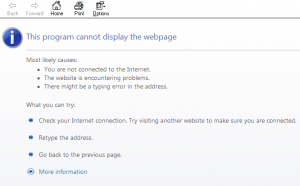Microsoft HTML help gotcha
I stumbled upon a “gotcha” today that could really perplex the average PC user.
I was putting some documents into folders based on the development language that they applied to. Naturally I put the C++ documents into the C++ folder, the Python documents into the Python folder etc.
documents/C++/
documents/python/
etc
These documents were in various formats – .pdf, .doc, .rtf, .txt, .chm.
After neatly filing all these documents I was surprised when I opened one of the .chm files to be greeted with this:
chm files are Microsoft’s compiled HTML help files that are the successor to the old windows help files, and are basically just compressed collections of html pages in a single file with indexing and contents built in.
The thing is, I knew that there was nothing wrong with the document I’d opened, because I had opened it just before I moved it into the new folder. I moved the file back into the folder it had originally been located in and opened it from there and it was fine (no errors – the title page displayed as I would expect).
This was mildly perplexing. I could open the file fine when it was in various folders on my machine, but when it was stored in my newly created folder, I was getting this internet connection error (on a local document that shouldn’t have been trying to access the internet at all).
The problem was, without thinking, I had placed it into the subfolder:
documents/languages/C#/
The compiled help file, being based on HTML uses Microsoft’s internet layout engine to render its pages, and its relative pathing was seeing the folder C#/ as a url bookmark instead of a valid part of a relative path.
Try it on your own machine – storing a chm document in a folder with a “#” in it effectively “breaks” the document.
Now I concede that using non alphanumeric folder names is poor practice, but to me this is more than just a weird quirk — it could absolutely baffle an ordinary user.
Should it be possible to “break” a help file and present a completely unhelpful error message just by putting it into a folder with a certain characteristic to its name?
Personally I don’t think so.
